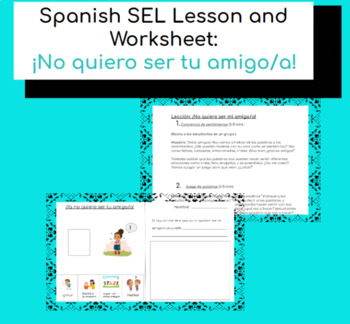Spanish SEL Lesson: "No quiere ser mi amigo/a!"
SEL EN ESPANOL
2 Followers
Grade Levels
PreK - 1st
Resource Type
Standards
CCSSW.K.1
CCSSW.K.5
CCSSSL.K.1
CCSSSL.K.1a
CCSSSL.K.3
Formats Included
- Google Drive™ folder
SEL EN ESPANOL
2 Followers

Made for Google Drive™
This resource can be used by students on Google Drive or Google Classroom. To access this resource, you’ll need to allow TPT to add it to your Google Drive. See our FAQ and Privacy Policy for more information.
Description
Spanish SEL lesson for teaching students how to manage the all too common situation when they are told by another student "I don't want to be your friend anymore!" or "No quiero ser tu amigo/a!". As we all know, this hurts students feelings badly and it takes time from our day to talk students through how to manage this situation. If you have been wondering how you can be proactive about this, whether at the beginning of the year or in the middle, here is your solution! This resource includes a lesson to be done either in one sitting or throughout the span of a few days (depending on your audience) and an accompanying worksheet with writing, drawing, cutting and gluing. Enjoy! :)
Total Pages
Answer Key
N/A
Teaching Duration
N/A
Report this resource to TPT
Reported resources will be reviewed by our team. Report this resource to let us know if this resource violates TPT’s content guidelines.
Standards
to see state-specific standards (only available in the US).
CCSSW.K.1
Use a combination of drawing, dictating, and writing to compose opinion pieces in which they tell a reader the topic or the name of the book they are writing about and state an opinion or preference about the topic or book (e.g., My favorite book is...).
CCSSW.K.5
With guidance and support from adults, respond to questions and suggestions from peers and add details to strengthen writing as needed.
CCSSSL.K.1
Participate in collaborative conversations with diverse partners about kindergarten topics and texts with peers and adults in small and larger groups.
CCSSSL.K.1a
Follow agreed-upon rules for discussions (e.g., listening to others and taking turns speaking about the topics and texts under discussion).
CCSSSL.K.3
Ask and answer questions in order to seek help, get information, or clarify something that is not understood.


